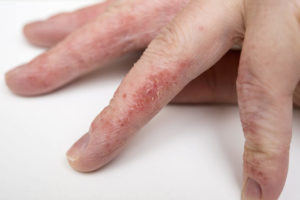Eczema
What is Eczema?

Eczema Causes
The exact cause of eczema is unknown. Eczema may be hereditary or even linked allergies or asthma. Many children with eczema will develop hay fever and/or asthma. Triggers cause eczema to flare up or get worse. Below are some of the common triggers individuals with eczema should be aware of and even try to avoid.
Irritants:
- Soaps and detergents
- Shampoos
- Dish Washing Liquids
- Bubble Bath
- Disinfectants like chlorine
Allergens:
- House dust mites
- Pets
- Pollens
- Molds
Hot or Cold Temperatures:
- Hot Weather
- High and Low Humidity
Foods:
- Dairy Products
- Eggs
- Nuts & Seeds
- Soy Products
- Wheat
Stress may also be linked to eczema as well as hormonal changes. Staphylococcus aureus bacteria on the skin may also be a cause of eczema. The staph bacteria multiply rapidly when the skin barrier is broken which may worsen symptoms, especially in young children.
Types of Eczema
Atopic Eczema
Atopic eczema is a chronic, itchy skin condition that is very common in children but can occur at any age. It is also known as eczema, atopic dermatitis and neurodermatitis. Atopic eczema usually occurs in people who have an “atopic tendency”. This means the patient may develop any or all of these linked conditions:
- Atopic eczema
- Asthma
- Hay Fever
These conditions are most common in families that have a parent, child or sibling that is affected. Atopic eczema also arises due to interaction with environmental factors such as weather and temperature. There are variations of what atopic eczema looks like. Most people have acute flares with inflamed, red, and sometimes blistered patches. In between flares, the skin may appear normal or suffer from dry, thickened, itchy areas.
Atopic eczema is most often affects skin on the face, hands, feet, inner elbows and back of knees. Other irritants that can make symptoms of atopic dermatitis worse include soap, rough clothing and household chemicals.
Dyshidrotic Dermatitis
This type of eczema is found only on the hands or feet. This eczema causes a burning or itching sensation and a blistering rash. The cause of this eczema is unknown. The first symptoms are typically severe itching. Blisters may then appear which may develop into scaly patches. Deep cracks can appear on the hands or fingers. This type of eczema may become chronic and painful. Treatments usually include cold, wet compresses or steroid drugs that need to be applied to the skin.
Nummular Dermatitis
This type of eczema affects men more than women. Men are usually affected before their mid-50s while women tend to develop it in their teen or early adulthood years. Nummular dermatitis causes coin-shaped marks that most often appear on legs, backs of hands, forearms, lower back and hips. This cause of this type of eczema is unknown. Factors such as cold, dry air and exposures to certain chemicals and metals may cause an outbreak. It is important to:
- Protect your skin from scratches and other injuries
- Take lukewarm baths or showers
- Apply moisturizers daily
- Apply steroid ointment to the rash
Neurodermatitis
People with neurodermatitis develop irritation spots that they frequently scratch out of habit. This type of eczema often affects the back, sides and back of neck, genitals, scalp, wrists, ankles and the inside of ears.
The main treatment for this type of eczema is to avoid scratching the area. Topical steroids may be prescribed to apply to the skin.
Eczema Treatments
Modifying your skin care routine and making lifestyle changes is the key component to controlling eczema. Mild soap and moisturizer should be used daily. Gentle soaps and moisturizers are available at Dermatology & Plastic Surgery of Arizona or at local drugstores. A good moisturizer will help conserve the skin’s natural moisture and needs to be applied immediately after baths or showers. It is also important to take steps to reduce stress and get regular exercise.
For more severe eczema, certain medications may be necessary. Hydrocortisone cream or ointment may help mild eczema while prescription steroid cream may be needed for more severe cases. Antihistamines such as Benadryl may help relieve symptoms. Corticosteroids may be prescribed by your dermatologist if other treatments fail.
To learn more about our Eczema procedure, or to schedule your consultation with Board-Certified Dermatologist Dr. Weyer, please fill out the form on this page. You can call our Tucson location at 520-207-3100 or our Sierra Vista location at 520-458-1787. We look forward to seeing you soon!

